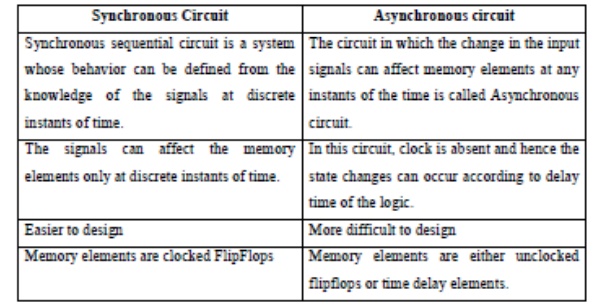Chapter: Digital Logic Circuits : Asynchronous Sequential Circuits and Programmable Logic Devices
Important Short Questions and Answers: Asynchronous Sequential Circuits and Programmable Logic Devices
ASYNCHRONOUS SEQUENTIAL CIRCUITS AND PROGRAMMABLE LOGIC
DEVICE
1.
What is the difference between synchronous and asynchronous circuit?
Solution:

2.
What are the different modes of operation in asynchronous sequential circuits?
Solution:
The different modes of operation are
fundamental mode and sequential mode circuits.
3.
Why are asynchronous counters referred to as ripple counters?
Solution:
Counter circuits made from cascaded
J-K flip-flops where each clock input receives its pulses from the output of
the previous flip-flop invariably exhibit a ripple effect, where false output
counts are generated between some steps of the count sequence. These types of
counter circuits are called asynchronous counters, or ripple counters.
6.
When does race condition arise in an asynchronous sequential circuit?
Race condition (race) is a condition
in sequential circuits in which two or more variables change at one time. In
practice, i.e. with non ideal circuits, there is a possibility of incorrect
operation under such a condition.
7.
Define state assignment.
State assignment is the process of
assignment of binary values to the states of the reduced state table in the
design of asynchronous circuits. In synchronous circuits-state assignments are
made with the objective of circuit reduction. Asynchronous circuits-its
objective is to avoid critical races.
8.
Define cycle.
If an input change induces a
feedback transitions through more than one unstable state, then such a
situation is called a cycle.
9.
Define hazard.
Hazard is the unwanted transient
i.e.. Spike or glitch that occurs due to unequal propagation delays through a
combination circuit.
10.
Define a stable state.
The time sequence of input, output
and FF states can be enumerated in a state table it is also called as
transition table. The table has four section present states, input, next state
and output.
11.
What is an asynchronous sequential circuit?
Solution:
If a circuit is not controlled by a
clock the transition of one state to next state occur whenever there is a
change in the input to the circuit at any time and hence this circuit is called
asynchronous sequential circuit.
12.
When do hazard occur?
Solution:
In a combinational network, which
has several logic gates and several paths from input to output, an input to the
network produces an output. In practice different paths through the network
from input terminal to output terminal may have different propagation delays.
When the input changes, it may so happen that undesirable switching transients
may appear at the output. If the network is a part of a larger asynchronous
sequential network, switching transients may cause malfunctioning of the
system. At this condition hazard will occur.
13.
Define glitch.
Solution:
The unwanted switching transients
that may appear at the output of a circuit are called glitch or Hazards.
14.
Define Static hazard.
Solution:
Static hazard is a condition, which
result in a single momentary incorrect output due
to change is a single input variable
when the output is expected to remain in the same state.
15.
What is the cause for essential
hazard?
Solution:
Operational error generally caused
by an excessive delay to a Feedback variable in response to an input change,
leading to a transition to an improper state. For example, an excessive delay
through an inverter circuit in comparison to the delay associated with the
feedback path may cause essential hazard.
Related Topics